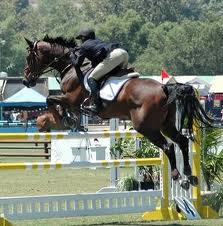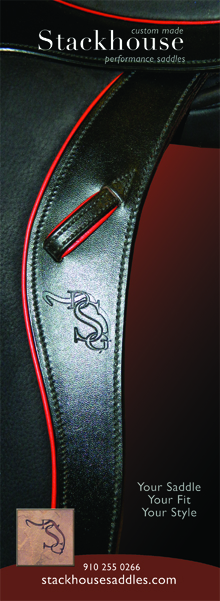Search the Site
An Exercise to Test the Foundation of Your Jumping (Current Freebie!)

Have you ever noticed how some horse and rider combinations are just so smooth that almost every jump looks the same? They seem to take every jump right in their stride, and appear to be in perfect harmony. The reason these riders are capable of performing so fluidly is because they have a solid base or foundation of jumping skills. How solid is your jumping foundation? Here is a simple test to find out...
Now, this test may sound extremely simplistic... and it is. Yet you would be surprised how hard it is for some horses and riders! It will point out every weakness or hole in your foundation, that will likely show up when you are tested out on course - making that smooth and harmonic performance that you are hoping for somewhat elusive to achieve.
Are you ready to hear what it is?? The exercise is to get your show jumping canter - a balanced, active uphill canter - and canter over a pole on the ground. So simple, yet how many of you test yourself regularly on this skill?
Your goal should be to maintain the quality of the canter - before the pole, over the pole, and after the pole. With the exact same stride length, rhythm, speed, energy level, balance, self carriage, and straightness throughout. When done well, it should look like the pole isn't even there - the horse just maintains that canter, and steps over the pole seamlessly and effortlessly.
Do NOT worry about finding a takeoff spot for the pole. Just keep focusing on maintaining the consistency of all the qualities mentioned above. You will find, that if you are successful in maintaining a consistent quality canter, you will get a takeoff spot that works. It may not be perfect, but it will be smooth. And only when you can easily and regularly maintain a good quality canter without it changing before, during, or after your pole, should you even think about trying to influence your horse's timing over the pole.
Why? Because being able to canter a pole while maintaining the quality of the canter is the solid foundation that all more advanced jumping is built on. Skip over that, and move on to more advanced exercises before that skill is mastered, and you may be forever struggling with quality. Solid basics is always the key to ease in moving up the levels.
What are some of the different things that can go wrong when cantering a pole? A familiar issue is the horse changing rhythm - with a quickening of the rhythm being the most common. Usually along with that, the horse loses some rideability - going against the rider's hand, and falling on the forehand. Which means that the horse will be going into the next pole (or jump) with less control and balance. And with each pole or jump on your course, things are probably going to get worse and worse. For some ideas on how to fix this problem, read this article on the horse that rushes jumps.
Less common is the problem of the horse losing energy and becoming weak at the pole. Often this is caused by the rider riding backwards to the pole, and using too much hand. Sometimes the horse just has a very cautious or timid nature. If you find you have this problem, read this article on how to get the best out of this type of horse.
Straightness issues are also quite common. Many times the horse will tend to lean to one side or the other - somtimes it is as mild as the horse leaning a bit on one rein, and sometimes it is severe enough to cause the horse to drift to the side of the pole. And if the horse is falling to one side badly enough, he can even have trouble maintaining his canter lead. It can be very enlightening to use striped poles when doing this exercise. As you can challenge yourself to be accurate in stepping right over the middle stripe.
When you get to the point where one pole is easy, increase the challenge by doing a full course of poles. With more to do, be careful that you don't lose sight of the details... the quality of your canter throughout is still your paramount goal. If as you go on around your course, you start to lose some quality - abort the course, and work on your flatwork for a few minutes. Then start up again with just a few poles to see if you can successfully maintain the quality.
It is easy to be tempted to overlook slight issues, like the horse leaning a bit on one rein, losing rhythm, or coming against the rider's hand on the approach to a pole. But if you regularly go back to this very basic foundation of jumping, and work on improving the quality and consistency of your technique, you WILL reap the benefits on course.






